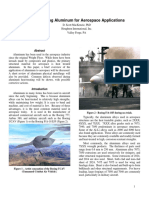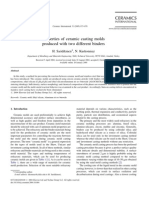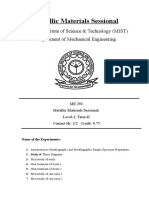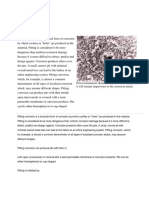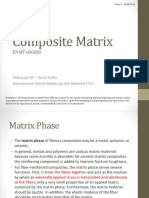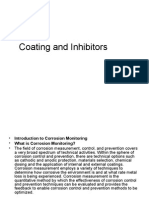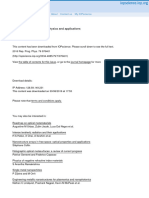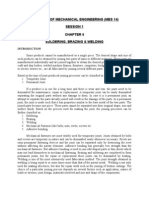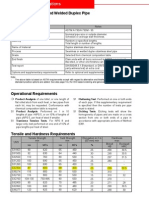Development of High Strength Construction Rebars
Development of High Strength Construction Rebars
Uploaded by
osman recaiCopyright:
Available Formats
Development of High Strength Construction Rebars
Development of High Strength Construction Rebars
Uploaded by
osman recaiOriginal Description:
Copyright
Available Formats
Share this document
Did you find this document useful?
Is this content inappropriate?
Copyright:
Available Formats
Development of High Strength Construction Rebars
Development of High Strength Construction Rebars
Uploaded by
osman recaiCopyright:
Available Formats
-58-
Proceedings of International Seminar on Production andApplication of HIgh Strength Seismic Grade Rebar ContainingVanadium
Beijing China
Development of High Strength Construction Rebars
Yang Caifu
(Central Iron & Steel Research Institute, Beijing 100081)
Abstract: The research, production and application of high strength rebars in China are reviewed.
Microalloying, afterheat treatment and fine-grain strengthening are the most effective methods in
developing high strength rebars. V-N microalloyed rebars have noticeable advantages over those
microalloyed with other elements. Enhanced nitrogen in vanadium-containing rebars promotes
the precipitation of V(C,N) particles which markedly improves the precipitation strengthening
effects of vanadium, 50% of which can be saved. The goal of saving costly FeV and reducing
costs are realized. Based on carbon steel and 20MnSi steel, grade 3 and grade 4 rebars with yield
strength of 400MPa and 500MPa respectively can be produced by afterheat treating, or ultra-fine
grain technologies; the alloy consumption is reduced and resources are saved at the same time. In
recent years, remarkable progress has been achieved in production and application of high
strength rebars.
Key words: high strength rebar, V-N microalloying, precipitation strengthing, afterheat
treatment, ultra-fine grain steel, seismic resistant rebar
As the biggest consumer among steel
products in China, rebars account for
one-fifth of total steel production and play
an important role in national economic
development. In recent years, the output
and consumption of hot rolled rebars
haveboth increased significantly to meet
the requirements of fast growth of building
industry. Fig.1 shows the production
growth of rebar in the past decade. It is
visible from the fig that annual output of
rebar had exceeded 100 million tons by
Currently, the domestic building market is
dominated by grade 2 rebars with yield
strength of 335MPa. After years of efforts,
some achievements have been made in
application of 400MPa rebars but the share
of high strength rebar is still lower. Grade 2
rebars account for 60% of all products and
the application of 500MPa rebars is almost
blank, and not filed in the architectural
design specification in our country.
However, in the developed countries,
rebars for construction have been upgraded
to 400MPa and above. For example, grade
4 rebars with yield strength of 500MPa
2007, nearly five times that in 1997.
Although the production of rebar has
substantially increased in the last years, the
product mix has been relatively backward.
have been widely used in Germany[2].In
terms of applications of building rebars,
our country lags far behind the world
advanced level. Rebar consumption can be
0 Introduction
2010
Proceedings of International Seminar on Production andApplication of HIgh Strength Seismic Grade Rebar ContainingVanadium
-59-
saved by 14% if the strength is upgraded
from grade 2 of 335MPa to grade 3 of
400MPa. Similarly, 10% of steel can be
saved if the strength is upgraded from
the expense of lower ductility and poor
bonding with concrete. Hot rolling with
pre-springing method was once commonly
used in Europe to produce high strength
grade 3 of 400MPa to grade 4 of 500MPa.
Therefore, there will be huge economic
efficiency and social benefits from rebar
upgrading. This paper mainly introduces
the research, development and applications
of high strength rebars for construction in
China.
rebar, namelyhot rolled torsion rebar, the
yield strength of which was from 360MPa
to 400MPa, and 500MPa grade in a few
cases. For consideration of cost, the torsion
rebar was gradually replaced by other hot
rolled rebars with same grades. In 1970's,
welding rebar was developed rapidly,
which promoted evoluation of rebar
production technologies. A great step
forward was achieved when the
1998-2009 Production of Rebars in China
140
Production, Million Tons
120
100
micro-alloyed rebar was developed [4-9].
Micro-alloying elements such as titanium,
niobium and vanadium were used to
produce high strength rebars based on low
carbon steel with improved toughness,
80
60
40
20
0
1998 1999 2000 2001 2002 2003 2004 2005 2006 2007 2008 2009
Fig.1 Rebars production in china
[1]
1 Research and development of
high strength rebars
1.1
History
High strengthening is an important
development trend of construction rebar. In
the beginning, by increasing carbon and
manganese contents, the earliest high
strength rebar was produced with carbon
content of about 0.35%, manganese
ranging from 0.90% to 1.45% depending
the size of product and yield strength from
350MPa to 400MPa. In the meanwhile,
another method for producing high strength
rebars was evolved based on cold
deformation[3]. The strength of rebars was
improved by drawing low-carbon steel at
ductility and welding performances.
Another new technology was rebar heat
treatment, known as Tempcore and
Thermex [10-11], successful applied in
Europe firstly. This was calledafterheat
treated rebarandquenching rebar. High
temperature after rolling was used for
quenching and residual heat in the central
part was utilized for self- tempering. This
method is currently the prevailing
production process for producing high
strength rebars in Europe. Micro alloying
and afterheat treatment are the main
processes for producing high strength
rebars in foreign countries. They are
widely used for producing 400MPa (grade
3), 500MPa (grade 4) and 600MPa(grade5)
high strength rebars.
Functional properties like seismic
-60-
Proceedings of International Seminar on Production andApplication of HIgh Strength Seismic Grade Rebar ContainingVanadium
Beijing China
resistance, flameproof, corrosion resistance
are generally required by construction
rebars, which represent another important
development direction. In order to improve
Mn-Si-Nb, with almost 20 brands, some of
which have been brought into the national
rebar standard. In the 1980s, researches
on manufacturing processes, brands,
the seismic and safety performances of
structures, series of high strength seismic
rebars have been developed by countries all
over the world. Japan takes the lead in the
field of seismic rebar applications by
developing series of high strength rebars
with strength ranging from 590MPa to
1275MPa[12].
Europe
has
placed
performance requirements like high
tensile/yield strength ratio, good ductility
performances and profiles of the low
alloyed rebars were conducted based on the
resources in China and internationally
advanced technologies. A series of
microalloyed grade 4 rebar products based
on 20MnSi (grade 2) were developed by
adding proper elements like vanadium,
niobium or titanium, namely 20MnSiV,
20MnSiNb, 20MnTi. In addition K20MnSi
afterheat treated grade 3 rebars was
and fatigue property. In order to improve
the durability of buildings, higher
requirement for construction rebars are put
forward, especially when the building is
under marine environment. One effective
produced. In late 1990s, for the sake of
further cost reduction and resources saving,
HRB 400 and HRB 500 high strength low
cost rebars were developed by V-N
microalloying[15-18]. In the meanwhile, high
method for improving rebar corrosion
resistance is surface treatment, such as
epoxy coating and galvanizing treatment.
Adding chromium, nickel and copper are
effective ways for improving inherent
corrosion resistance. In order to obtain
longer service life, non-corrosive rebars
have been developed and used by some
European and American countries in the
recent years[13-14].
The research and development on
rebars in China started in the mid of 1960's.
Before this, the rebar standard was
developed with referrence to the standard
for the similar products of Soviet Union,
mainly carbon rebar. Since 1960s, our
strength carbon rebars with ultra-fine
grain has been developed with the support
of national 973 project[19]. The
successful developments of these products
have effectively promoted the application
of grade 3 rebar in our country. However,
in the field of seismic resistant, flameproof
and corrosion resistant rebars, our research
work is still at the initial stage.
1.2
Production technology of high
strength rebars
Rebar performance mainly depends on
chemical composition and manufacturing
parameters .As welding techniques are
widely used in modern architectures, the
way of adding carbon or equivalent content
country has successfully developed series
of low alloyed rebar products including
Mn-Si,Si-V,Si-Ti, Si-Nb,Mn-Si-V and
to improve strength is infeasible. In order
to make up for the loss of strength due to
decreased carbon content, alternative
2010
Proceedings of International Seminar on Production andApplication of HIgh Strength Seismic Grade Rebar Containing Vanadium
process routes are available which include
cold deformation, afterheat treatment,
microalloying, grain refining and etc.
1.2.1
-61-
increase significantly as a result of cold
deformation. Therefore, the manufacturing
practice of cold deformation to improve
strength of rebar has become a history.
Cold deformation technology
1.2.2
Afterheat treating technology
Heat treatment after rolling is the
primary route for producing high strength
rebar in Europe and this method is to
obtain tempered martensite on the surface
of rebar to realize strengthening. The yield
strength of common rebar can reach
400MPa and 500MPa to meet performance
requirements of high strength rebar. On the
basis of low carbon manganese steel, rebar
Cold deformation is one of the earliest
methods for rebar production. Although
strength is obviously improved by cold
deformation, the ductility is much damaged
accordingly. As shown in fig.2, the strength
of hot rolled low carbon rebar increases
significantly while the ductility index
Rm/Re drops dramatically after 5%
deformation.
with yield strength 600MPa can be
produced by afterheat treated process
coupled with microalloying method. Table
1 shows the chemical composition of
typical high strength rebar with afterheat
treated technology in the foreign country.
From the table, it can be seen that through
afterheat treatment content of alloying
elements in the high strength rebar is lower,
which shows significant cost advantages.
Except one-off equipment investment
(water-cooling equipment after rolling),
theres little increase in production cost.
Therefore, afterheat treating technology is
an effective way for producing high
strength low cost rebars.
(Diameter of rebar: 12mm, stretching strain: 5%)
Fig.2 Effect of cold deformation on
mechanical property of rebars[2]
The strength of cold deformation rebars
increases while ductility drops noticeably,
which can hardly meet the requirements for
construction steel, especially the seismic
resistant steel. Besides, production costs
Tab.1 Chemical composition of typical high strength
rebar produced by afterheat treated process[2]
V
Yield strength level/MPa
Si
Mn
400
0.160.22
0.200.30
0.400.60
0.012
500
0.160.22
0.200.30
0.600.80
0.012
600
0.160.22
0.200.35
0.801.00
0.030.04
0.0100.012
-62-
Proceedings of International Seminar on Production andApplication of HIgh Strength Seismic Grade Rebar ContainingVanadium
Beijing China
1.2.3
Microalloying technology
Microalloying utilizes two advanced
technologies
which
are
fine-grain
strengthening
and
precipitation
research
achievements
of
V-N
microalloyed rebars.
Titanium microalloying
Titanium is the earliest micro alloyed
strengthening to improve strength. Micro
alloying elements are added to rebar such
as titanium, niobium and vanadium with a
content ranging from 0.02% to 0.15%.
Combined with appropriate process control
method, the strength can increase doubly.
Microalloying technology was one of the
most significant achievements in physical
metallurgy in latter half of 20 century,
which provides another economic and
element applied in steel. TiC is a
significant contributor to precipitation
strengthening, small quantity of which can
increase strength significantly. However,
titanium has strong binding force with
oxygen, sulfur and nitrogen, forming
oxides, sulfide and nitrides prior to
formation of TiC. This will give rise to
difficulty to control titanium content on a
reliable basis, resulting in fluctuation in
effective method for producing high
strength steels. The option of microalloying
elements depends on the their binding
abilities with oxygen, sulfur, carbon,
nitrogen, etc, as well as the carbide/nitride
strength of the steel. Oxides and sulfides of
titanium are formed in molten steel;
Similarly, TiC is formed in solidification
process and can easily become bulky
inclusions. For the above reasons, titanium
dissolvability at different temperatures and
specific conditions of production process.
Besides technical consideration, economic
viability is also an important factor to
consider for technological selection. Three
kinds
of
technologies,
namely
Ti-microalloying, Nb-microalloying and
V-microalloying are introduced for rebar
production and emphasis is given to the
micro alloyed method is abandoned for
strength improvement and this method has
been used in the field of Ti-treatment and
oxide metallurgy. Welding performance is
improved by adding small quantity of
titanium (generally 0.010% to 0.020%) to
form fine TiO and TiN, A lot of steels
containing titanium such as 20MnTi rebar
in the past are discontinued in our country.
Fig.3 NbC, TiC and VN dissolvability at different temperature[3]
2010
Proceedings of International Seminar on Production andApplication of HIgh Strength Seismic Grade Rebar ContainingVanadium
-63-
Niobium microalloying
Niobium microalloying is widely used
in steel sheet and strip production.
However, the application is restricted by
12mm25mm)rebar. Based on 20MnSi,
coupled with accelerated cooling process
after rolling, the technical index of the
rebar containing niobium of 0.02% to
dissolvability of Nb(C,N) in rebar
production .The pass system of wire and
rod mill is fixed and efficient rolling with
fast speed is adopted. With heating up
rolling scheme the temperature of rebar in
exit of finishing stand is more than 1100.
Therefore, it is difficult to meet
technological conditions for Nb-containing
steel production which requires low
temperature and large deformation.
0.03% can meet grade 3 rebar
requirements,
Vanadium/vanadium-nitrogen
microalloying
The microalloying process is mainly
used to develop high strength weldable
rebars around the world. During rebar
production process, the high rolling speed
and high finishing temperature are quite
desirable for application of vanadium
Furthermore, the content of carbon in rebar
is from 0.20% to 0.25%, which is relatively
higher. It can be seen in Fig.3 that under
typical composition of rebar (0.20%C),
only0.02% of niobium can be dissolved in
microalloying technique. The rebar
standard issued in China also recommends
the use of vanadium microalloying to
produce grade 3 rebars with yield strength
400MPa at least[20].However, vanadium
the steel at the heating temperature of
1,200 .
Although the effect of niobium
fine-grain strengthening is difficult to exert
in rebar production process, the
precipitation of Nb(C, N) contributes a
little to strengthening. In order to make use
of strengthening effect of niobium, further
research has been done which has
promoted the application of niobium of
grade 3 rebars. The primary measure is to
decrease precipitation temperature and
obtain fine precipitate phase particles of
Nb(C,N). Niobium microalloying is
successfully applied in rebar of grade 3 by
accelerated cooling after rolling and
added in rebars will increase the production
costs. It is known that microalloying
element takes effects by precipitation of its
carbides/nitrides. Microalloyed nitrides
have noticeably better strengthening
effectiveness than that of carbonides, for
nitrides particles are more stable. Research
results[4-5] indicate that nitrogen is a
cost-effective
alloying
element
in
vanadium microalloyed steels, and the
strength can increase from 7MPa to 8MPa
per 10ppm of nitrogen added. The
successful applications of low-cost
nitrogen help to improve strengthening
effect of steel containing vanadium,and
achieve the goals of saving alloy and
trace-titanium treatment which can reduce
the adverse effects of Nb(C,N), especially
for the widely used small size(
reducing costs. In order to further reduce
the costs of high strength rebar and explore
the potential of microalloying steel,
-64-
Proceedings of International Seminar on Production andApplication of HIgh Strength Seismic Grade Rebar ContainingVanadium
Beijing China
extensive researches on production of high
strength rebar with V/N microallying have
been conducted home and abroad[15-18].
(1) Effect of nitrogen
steel to which FeV is added, vanadium
exists mainly as solid solution which
accounts for 56.3% of total vanadium
content, while only 35.5% of vanadium
Fig.4 shows the effect of nitrogen on
strength of rebar containing vanadium.
With almost the same content of vanadium,
the strength of V-N microalloyed rebars is
much higher than that of vanadium
microallyed steel. It can be seen that with
enhancement of 100ppm of nitrogen, the
yield strength and tensile strength of V-N
microalloyed rebar increase by 117.5MPa
and 135MPa, respectively, compared to
vanadium containing steel. Experimental
result shows that nitrogen markedly
improves the strengthening effectiveness of
vanadium in steel, which means nitrogen is
a very effective strengthening element for
precipitates in the form of V(C,N).The
results reveal that most of the
microalloying elements in vanadium
containing steel do not work toward
precipitation strengthening and it is a waste
of vanadium. On the contrary, in V-N steel,
70% of vanadium forms V(C,N)
precipitates and only 20% dissolves in the
matrix. Therefore, nitrogen added to steel
alters the vanadium phase distribution and
s trength, M P a
YS
100%
90%
Distribution Ratio
of Vanadium, %
rebars containing vanadium.
800
promotes precipitation of vanadium
dissolved in the matrix, thus improving the
precipitation strengthening of vanadium.
TS
700
600
80%
70%
50%
40%
30%
500
20%
400
10%
300
0%
200
V -S teel
S teel
YS
TS
V -N S teel
0 .1 1 % V - 8 5 p p m[N ] 0 .1 2 % V - 1 8 0 p p m[N ]
4 4 2 .5 MPa
5 8 5 MPa
5 60 MPa
7 2 0 MPa
Fig. 4 Effect of N on strength of V rebars
steel[16]
(2) Vanadium distribution and precipitation phase in rebars
Vanadium distribution is shown in
Fig.5. It can been seen there is an evident
difference in phase distribution of
vanadium between high-nitrogen steel and
low-nitrogen steel. In vanadium containing
V V(C,N)
V M3C
V sol
60%
V Steel
VN Steel
Fig. 5 Vanadium distribution in V-steel and V-N
steel[15]
Phase analysis result shows that the
fraction of fine particles with a size of less
than 10nm in vanadium containing rebar is
just 21.1%, whereas, the fraction is up to
32.2% in V-N rebar. The increase of fine
and dispersed V(C,N) precipitated phase is
the primary reason for strength rise of V-N
rebars.
S =85.7+37[Mn]+83[Si]+17.4D-1/2 +PR
Proceedings of International Seminar on Production andApplication of HIgh Strength Seismic Grade Rebar ContainingVanadium
V-Steel RelRel(20MnSi)1056[V%]
V-N Steel RelRel(20MnSi)1994[V%]
(3) Strengthening mechanism of V-N
rebars
On the basis of research results, the
strength of microalloyed steels can be
expressed as[21]:
S =85.7+37[Mn]+83[Si]+17.4D-1/2 +PR
where 37[Mn]+83[Si] is solid solution
strengthening
factor,
17.4D-1/2
is
fine-grain strengthening factor and PR is
precipitation
strengthening
factor.
According to experimental results of ferrite
grain size and yield strength of the sample
steel,
the
contribution
of
each
strengthening factor to the yield strength
can be estimated by the above formula and
the result is shown in Fig.6.
Yield Strength MPa
600
500
165
65
400
300
preciptation
Grain Size
170
200
220
solid solution
200
120
base
90
90
85
85
85
20MnSi
V-rebar
V-N rebar
100
Fig.6 Strengthening Mechanism of 20MnSi, V
rebars and V-N rebar
It can be seen that effect of matrix
strengthening
and
solid
solution
strengthening is basically the same for the
three rebars, the strength difference is
caused by different effects of precipitation
strengthening and fine-grain strengthening.
The effect of precipitation strengthening
and fine-grain strengthening of V-N steel is
better than that of V containing steel,
23MPa by
86MPa by
totaling
contributing
-65-
fine-grain strengthening and
precipitation strengthening,
109MPa.Comparison
of
factors to the precipitation
strength between the two steels suggests
that PR in V-N rebar doubles that in
vanadium
containing
steel.
The
incremental strength from precipitation
accounts for 73.2% of total strength
increment of the steel. It can be seen that
by addition of nitrogen, vanadium can play
a greater role in precipitation strengthening
and fine-grain strengthening, which
contribute to significant improvement in
yield strength. The result of regression
equation shows that the strengthening
ability of vanadium in V-N rebars almost
doubles that of vanadium-containing rebar.
V-Steel RelRel(20MnSi)1056[V%]
V-N Steel RelRel(20MnSi)1994[V%]
(4) Effect of accelerated cooling after
rolling
The products which meet the
requirements of grade 3 and grade 4 rebars
with lower content of vanadium can be
produced through accelerated cooling
process. Fig.7 indicates yield strength
changing with content of vanadium for
vanadium containing rebar, V-N rebar and
V-N rebar produced by accelerated cooling.
600
V-N rebars
(Accelerated cooling)
Yield Strength, MPa
2010
V-N rebars
550
V rebars
500
450
rebar diameter: 16-32mm
400
0.00
0.02
0.04
0.06
0.08
0.10
0.12
0.14
V content, %
Fig.7 Effects of V content and ACC process on
the strength of rebars
-66-
Proceedings of International Seminar on Production andApplication of HIgh Strength Seismic Grade Rebar ContainingVanadium
Beijing China
It can be seen that with the same
strength, V-N rebars save V resources
substantially compared with rebars
containing vanadium only , with V
the strength of carbon rebars and 20MnSi
rebars. Common carbon steel is able to
satisfy the performance requirements of
grade 3 rebar with minimum yield strength
consumption decreasing from 0.06%
0.08% to 0.03% 0.04% for 400MPa
rebars, and from 0.07% 0.12% to
0.06% 0.08% for 500MPa rebars. By
accelerated
cooling
process,
the
consumption of vanadium can be reduced
to 0.02%0.03% for 400MPa V-N rebars
and 0.04% 0.05% for 500MPa V-N
rebars. It follows that FeV consumption
and costs will be saved by adopting
of 400MPa by refining grains. For 20MnSi
rebar, the strength obtained is more than
500MPa.
Grain refining is an effective method
for raising strength while improving
toughness at the expense of reducing
tensile/yield ratio. It can be seen in Fig.8
that tensile/yield ratio of carbon rebars and
20MnSi
rebars
with
fine-grain
strengthening is reduced to 1.20 and below,
microalloying technique combined with
accelerated cooling process.
1.2.4 Technology of fine-grain rebars
Based on973ultra-fine grain steel
project, the research work of high strength
less than the ratio of 1.25, a minimum
requirement by the seismic rebar. Another
problem is weldability of this kind of rebar.
The grain of heat affected area will grow
due to high temperature during the welding
fine-grain rebars have been conducted in
China. The ultra-fine grain structures can
be obtained through DIFT technique as
well as deformation at Ar3 temperature.
Fig.8 shows the effects of fine grains on
process, and welded joint will intenerate at
the same time. Improving tensile/yield ratio
and researching connection technology are
the primary efforts toward promoting
fine-grain rebars in the future.
350
1.2
300
1.15
b/
250
1.1
200
0.17%C-0.60%Mn-0.29%Si-0.012Ti
150
1.05
3
9 10 11 12
grain size m
m
1.45
800
1.4
750
1.35
700
1.3
650
1.25
600
1.2
b/s
550
1.15
500
1.25
400
MPa
450
1.5
b
Tensile/ yield
1.3
strengthMPa
tensile
yield strength
500
850
1.35
tensile strengthMPa
yield strength
MPa
550
1.1
450
1.05
0.22%C-1.46%Mn-0.5%Si
400
1
0
m
grain
size m
Fig.8 Effect of ferrite grain size on the strength of plain C and 20MnSi rebars[19]
2 Production and application of high
strength rebars
Fig.9 shows production of grade 3
rebar in China in recent years. In the year
2010
Proceedings of International Seminar on Production andApplication of HIgh Strength Seismic Grade Rebar ContainingVanadium
-67-
of 2000, its output was only 260 thousand
tons, accounting for 1% of the total rebar
production. By 2008,the output had
reached 33 million tons, accounting for
strength level. V-N microalloying is
adopted to play a role in strengthening
precipitation as well as improving strength,
saving alloy consumption and reducing
one-third of the total. High strength rebar
production and application in China has
developed rapidly. It can be seen in Fig.10
that increasing output of grade 3 rebar has
significantly contributed to the product mix.
Although the output of grade 3 rebar has
substantially increased, its share is still
lower. 20MnSi rebar of grade 2 has the
biggest share in the construction rebar
market, namely 60%.The application of
production costs. Through optimization of
chemical composition, the consumption of
vanadium in V-N microalloying high
strength rebars can be reduced to the
content ranging from 0.02% to 0.04%, half
that of V-Fe microalloyed rebar.
Production experiences indicate that
the mechanical properties of V-N micro
alloyed rebars are quite stable and the
strength is controlled with a variation of
building rebars indicate that our country still
lags far behind the world advanced level.
V/V-N
microalloying
is
the
predominant process for producing high
strength rebars for construction. Based on
75MPa, which can satisfy class- one
seismic requirements. According to the
statistical data of mass V-N rebar
production, the way that strength is
affected by dimension specification is
20MnSi, appropriate vanadium or V-N is
added to steel to meet performance
requirements of 400MPa and 500MPa high
strength rebars. Table 2 lists the typical
chemical composition of 400MPa and
500MPa rebars produced by converter
process. It can be seen that the
consumption of vanadium needed in V-N
steel is much less than that in the steel
containing vanadium only with the same
identified. As shown in Fig.11, statistical
results indicate that the average variation of
yield strength is 17MPa while the tensile
strength is 19MPa by using billets with the
same chemical composition to produce
rebars of different specifications. V-N
micro alloyed rebars of different
specifications exhibit similar properties
suggesting that the effects of specification
are not evident.
1995-2009 China Rebars Steels Output
Production of Grade 3 Rebars
103 102
60
50
88
80
71
58
44
15
17
15
25
21
12.96
5.89
1.94
1.07
0.26
40
30
22.74
29
26
32.72
32.43
20
13.07
10
09
07
06
05
04
03
02
01
00
99
98
08
20
20
20
20
20
20
20
20
20
20
19
97
Fig.9
19
96
19
19
95
Production of Grade 3 Rebars in China
Production of Grade3 rebars,
Million Tons
122
19
Total Output of Rebars,
million tons
Total Production
130
120
110
100
90
80
70
60
50
40
30
20
10
0
-68-
Proceedings of International Seminar on Production andApplication of HIgh Strength Seismic Grade Rebar ContainingVanadium
Beijing China
2007 China Rebars Mix
2006 China Rebars Mix
Grade V,
0.04%
Grade IV,
0.28%
Grade I,
8.29%
Grade I,
4.60%
Grade IV,
0.16%
Grade III,
23.37%
Grade III,
31.55%
Grade II,
63.65%
Grade II,
68.05%
Fig.10 Rebar product mix in China
Tab.2 Chemical composition of 400MPa and 500MPa
rebars produced by converter process
Grade
Alloy
400MPa
V-N
Si
Mn
PS
0.20-0.24
0.45-0.60
1.25-1.45
<0.035
Specificatio
n/mm
16-40
0.03-0.04
0.008-0.012
6-16
0.02-0.03
16-40
0.07-0.09
V-Fe
0.20-0.24
0.45-0.60
1.25-1.45
<0.035
0.003-0.006
10-16
0.05-0.07
500MPa
V-N
0.20-0.24
0.20-0.24
0.45-0.60
650
600
550
500
450
400
350
300
1.40-1.55
1.40-1.55
0.05~0.07
0.010-0.015
16-32
0.07-0.09
0.012-0.018
32-40
0.07~0.12
0.003-0.006
16-32
<0.035
<0.035
s(MPa)
b(MPa)
750
700
(MPa)
MPa
V-Fe
0.45-0.60
650
600
550
500
450
400
8 10 12 14 16 18 20 22 24 26 28 30 32 34 36 38 40 42
,mm
12
16
20
25
32
40
(mm)
Fig.11 Effect of the size of rebars on mechanical properties[22]
A significant advantage of V-N rebars
is the excellent anti-strain aging
performance. Table 3 shows the results of
the strain aging evaluation of V-N rebars
and 20MnSi rebars. The results show that
strain aging phenomenon occurs obviously
Tab.3
in 20MnSi rebar after strain aging
treatment, which results in significant
strength increase. However, V-N rebar
eliminates the adverse effects of strain
aging on properties of steel and non-strain
aging steel is obtained.
Strain Aging Behavior of V-N and 20MnSi Rebars
Non-aging
Steel
After aging
s/MPa
b/MPa
5/%
s/MPa
b/MPa
5/%
V-N
460
640
27
470
655
25
20MnSi
380
575
30
425
615
24.5
2010
Proceedings of International Seminar on Production andApplication of HIgh Strength Seismic Grade Rebar ContainingVanadium
-69-
The successful application of V-N
microalloying technology in high strength
rebars provides a new effective and
economic method for producing high
performance advantages such as reliable
performance, little strength variation, low
strain
aging
sensibility,
excellent
wdldability which can meet seismic design
strength rebar. Nitrogen is added into
vanadium containing steel to play a role in
precipitation strengthening, as well as
improving strength, saving costly FeV and
reducing
production
cost.
V-N
microalloyed rebars of grade 3 are widely
producedobtaining great economic and
social benefits.
requirements.
(3)Grain refinement is an effective
method for producing low cost high
strength rebars. Based on common carbon
steel and 20MnSi steel, grade 3 and grade 4
rebars with yield strength of 400MPa and
500MPa respectively can be produced by
ultra-fine grain technology, the alloy
consumption is reduced and resources are
saved. The applications of afterheat treated
Conclusions
(1) Remarkable progress has been
made in production and application of high
strength rebars in China and the output of
400MPa rebars has reached 33 million tons,
accounting for one-third of the total rebar
rebars are restricted in many aspects. More
efforts should be made to develop
associated application technologies such as
welding process, connecting technology as
well as development of standards and
production. However, 500MPa rebar has
been virtually not used in China, lagging
far behind the world advanced level. It will
be a lasting and arduous task to promote
upgrading of products and enlarge
proportion of grade 3 and grade 4 rebars
for construction.
(2) V-N microalloying is an effective
way for producing high strength low cost
rebars. Nitrogen added into V-containing
rebars can play a role in promoting V
precipitation,
thus
improving
strengthening effect remarkably, so as to
save costly FeV and reduce production
costs.
Compared
with
vanadium
microalloying, V-N microalloyed rebars
specifications, etc.
can save 50% of vanadium, showing
evident cost-saving advantages. In addition,
V-N
microalloyed
rebars
exhibit
[6]
References
[1]
Annual report on China Iron & Steel Statistics,
China Iron & Steel Association, (2006-2009).
[2]
D.Russwurm and P.Wille. "High Strength Weldable
Reinforcing Bars". Microalloying95, Pittsburgh, PA,
ISS, 1995.
[3]
H.G. Trotter, High Strength Steel Reinforcement, The
Metallurgist and Materials Technologist, February
1977, p.73-76.
[4]
Vanadium
Steel-Reinforcing
Bars,
VANITEC
Monograph No.1, Publication No. V025, 1976.
[5]
A.M. Sage, Effect of V, N, Al on the mechanical
properties
of
reinforcing
bar
steels,
Metals
Technology, February, 1976.
I. Lindberg, Weldable high strength reinforcing bars
microalloyed with vanadium and nitrogen, Vanadium
Steels Conference, Krakow, 9-10 October 1980.
-70[7]
[8]
Proceedings of International Seminar on Production andApplication of HIgh Strength Seismic Grade Rebar ContainingVanadium
M.Korchynsky. "Overview". Proc. 8th Process Tech.
Caifu,
Zhang
Shuping,
S.Zajac, T.Siwechi, etal. strengthening mechanism in
Microalloyed rebars Steels, HSLA Steels2000 (eds.
vanadium microalloyed steel intended for long
Liu Guoquan,etal, Metallurgical Industry Press,
products,
2000,10), 4th International Conf. on HSLA Steels,
International,
vol.38,
No.10,
of
Liu
Precipitation
ISIJ
Behavior
Yongquan,
Conf., Iron and Steel Society, 1988:7987.
1998:1130-1139.
[9]
[15] Yang
Beijing China
Vanadium
in
V-N
Oct.30-Nov.2, Xian China, p152-157.
S.Zajac, R.Lagneborg, T.Siwechi. "The Role of
[16] Zhang Yongquan,Yang Caifu, Liu Shuping. Research
Nitrogen in Microalloyed Steels". Proc. Int. conf.
on economic grade 3 rebars for buildings .Iron and
Microalloying 95, Pittsburgh, PA, ISS, 1995:321
Steel, vol.35, No.1, 2000, p.43-46.
340.
[10] M. Economopoulos, Y. Respen, G. Lessel, G. Steffes,
Application of the Tempcore Process to the
Fabrication of High Yield Concrete-reinforcing Bars,
C.R.M., No.45, December 1975.
[11] P. Simon, M. Economopoulos, P. Nilles, Tempcore: A
new process for the production of high-quality
reinforcing bars, Iron and Steel Engineer, March 1984,
p.53-57.
[12] N.KURODA, M.YOSHIKAWA, High Production
[17] Yang
Caifu,Zhang
Yongquan,Liu
Shuping,
Strengthening mechanism of V-N micro alloyed
rebars, Iron and Steel, vol.36, No. 5, 2001, p.55-57.
[18] Ji
Huaizhong,Yang
Caifu,Zhang
Yongquan,
Strengthing effects of nitrogen on 20MnSi rebar
containing
vanadium.Special Steel, Vol.21,No.5,
2000,p.20-23.
[19] Weng Yuqing,Ultra-fine grain steel, Metallurgical
Industry Press,Beijing,2003.
[20] National
Standard
GB1499-1998,
Hot
Rolled
Capacity Steel Bar Mill of High Strength Steel Bars
Ribbed Steel Bars for the Reinforcement of Concrete,
for Concrete Reinforcement, Kobe steel technical
1998.10. (in Chinese).
NewspaperVol.58No.22008, p.7-11.
[13] Guidance on the use of stainless steel reinforcement,
The Concrete Society, 1998.
[14] M.Rosso, M.Comoglio, G.Metotti, D.Gyppaz, La
Mettallurgia Italiana, Vol.90, No.2, 1998, p.35.
[21] Yong Qilong,Ma
Mingtu,WuBaorong,Micro-alloyed steel-physics
and mechanical metallurgyMechanical Industry
Press, Beijing, 1989:57.
You might also like
- Selection of Polymers With Functional Groups For Daytime Radiative CoolingNo ratings yetSelection of Polymers With Functional Groups For Daytime Radiative Cooling5 pages
- Heat Treating Aluminum For Aerospace Applications: Figure 2 - Boeing F/A-18F During Sea TrialsNo ratings yetHeat Treating Aluminum For Aerospace Applications: Figure 2 - Boeing F/A-18F During Sea Trials10 pages
- Ballistic Steels Secure / Secure M: Plates For Highest ProtectionNo ratings yetBallistic Steels Secure / Secure M: Plates For Highest Protection9 pages
- Effect of Seawater Chlorination On The Erosion CorrosionNo ratings yetEffect of Seawater Chlorination On The Erosion Corrosion19 pages
- A Survey of Concussion Powders: K. L. and B. J. KosankeNo ratings yetA Survey of Concussion Powders: K. L. and B. J. Kosanke13 pages
- Corrosion and Surface Chemistry of MetalsNo ratings yetCorrosion and Surface Chemistry of Metals615 pages
- Instant ebooks textbook Transparent Ceramics: Materials, Engineering, and Applications 1st Edition Adrian Goldstein download all chapters100% (3)Instant ebooks textbook Transparent Ceramics: Materials, Engineering, and Applications 1st Edition Adrian Goldstein download all chapters55 pages
- Performance of Reinforced Concrete Beam For Impact LoadNo ratings yetPerformance of Reinforced Concrete Beam For Impact Load17 pages
- Ballistic Testing of Thyssenkrupp Steel Europe Armor Steel in Accordance With U.S. Military Armor SpecificationsNo ratings yetBallistic Testing of Thyssenkrupp Steel Europe Armor Steel in Accordance With U.S. Military Armor Specifications11 pages
- Difference Between Hardness and Harden AbilityNo ratings yetDifference Between Hardness and Harden Ability9 pages
- Ballistic Impact Response of Elastomer Retrofi - 2023 - International Journal ofNo ratings yetBallistic Impact Response of Elastomer Retrofi - 2023 - International Journal of22 pages
- Ceramics International: Mahamoud S. Alkathy, Rahul Gayam, K.C. James RajuNo ratings yetCeramics International: Mahamoud S. Alkathy, Rahul Gayam, K.C. James Raju10 pages
- United States Patent (19) : Tasdemiroglu 11 Patent Number: 4,664,967 (45) Date of Patent: May 12, 1987No ratings yetUnited States Patent (19) : Tasdemiroglu 11 Patent Number: 4,664,967 (45) Date of Patent: May 12, 19876 pages
- Corrosion of Water Walls and Superheaters in Wte MSW PlantsNo ratings yetCorrosion of Water Walls and Superheaters in Wte MSW Plants114 pages
- Effect of Niobium On The As-Cast Microstructure of Hypereutectic High Chromium Cast IronNo ratings yetEffect of Niobium On The As-Cast Microstructure of Hypereutectic High Chromium Cast Iron4 pages
- Wear Characteristics of Heat Treated Hadfield Austenitic Manganese Steel For Engineering ApplicationNo ratings yetWear Characteristics of Heat Treated Hadfield Austenitic Manganese Steel For Engineering Application15 pages
- Patent Application Publication (10) Pub. No.: US 2016/0102949 A1No ratings yetPatent Application Publication (10) Pub. No.: US 2016/0102949 A111 pages
- Corrosive Damage in Metals and Its Prevention83% (6)Corrosive Damage in Metals and Its Prevention36 pages
- Effect of Cooling Rate On Microstructure and Mechanical Properties of Gray Cast Iron - IsINo ratings yetEffect of Cooling Rate On Microstructure and Mechanical Properties of Gray Cast Iron - IsI6 pages
- A Review of Metasurfaces Physics and ApplicationsNo ratings yetA Review of Metasurfaces Physics and Applications41 pages
- Metallurgy Unlocked Mastering Metallurgical Diploma Questions and AnswersFrom EverandMetallurgy Unlocked Mastering Metallurgical Diploma Questions and AnswersNo ratings yet
- Development of High Strength Construction RebarsNo ratings yetDevelopment of High Strength Construction Rebars13 pages
- Modern High Strength Niobium Microallyed Structural SteelsNo ratings yetModern High Strength Niobium Microallyed Structural Steels26 pages
- Guideline For Selection of Instrument Tubing andNo ratings yetGuideline For Selection of Instrument Tubing and6 pages
- Metals and Metal-Working in Old Japan (1915)80% (5)Metals and Metal-Working in Old Japan (1915)152 pages
- The Joint Properties of Brass Plates by Friction Stir WeldingNo ratings yetThe Joint Properties of Brass Plates by Friction Stir Welding8 pages
- Recovery of Iron From Red Mud by High-Temperature Reduction of Carbon - Bearing BriquettesNo ratings yetRecovery of Iron From Red Mud by High-Temperature Reduction of Carbon - Bearing Briquettes4 pages
- Published by - Bapi Saha, Mobile-9088857120No ratings yetPublished by - Bapi Saha, Mobile-90888571204 pages
- High-Performance Solid Carbide End Mill Catalog: 3rd Edition100% (1)High-Performance Solid Carbide End Mill Catalog: 3rd Edition163 pages
- A540A540M-11 Standard Specification For Alloy-Steel Bolting For Special ApplicationsNo ratings yetA540A540M-11 Standard Specification For Alloy-Steel Bolting For Special Applications8 pages
- Te and Se Mineralogy of The High-Sulfidation Kochbulak and Kairagach Epithermal Gold Telluride DepositsNo ratings yetTe and Se Mineralogy of The High-Sulfidation Kochbulak and Kairagach Epithermal Gold Telluride Deposits21 pages
- Effects of Heat Treatments On Steels For Bearing ApplicationsNo ratings yetEffects of Heat Treatments On Steels For Bearing Applications7 pages
- Selection of Polymers With Functional Groups For Daytime Radiative CoolingSelection of Polymers With Functional Groups For Daytime Radiative Cooling
- Heat Treating Aluminum For Aerospace Applications: Figure 2 - Boeing F/A-18F During Sea TrialsHeat Treating Aluminum For Aerospace Applications: Figure 2 - Boeing F/A-18F During Sea Trials
- Ballistic Steels Secure / Secure M: Plates For Highest ProtectionBallistic Steels Secure / Secure M: Plates For Highest Protection
- Effect of Seawater Chlorination On The Erosion CorrosionEffect of Seawater Chlorination On The Erosion Corrosion
- A Survey of Concussion Powders: K. L. and B. J. KosankeA Survey of Concussion Powders: K. L. and B. J. Kosanke
- Instant ebooks textbook Transparent Ceramics: Materials, Engineering, and Applications 1st Edition Adrian Goldstein download all chaptersInstant ebooks textbook Transparent Ceramics: Materials, Engineering, and Applications 1st Edition Adrian Goldstein download all chapters
- Performance of Reinforced Concrete Beam For Impact LoadPerformance of Reinforced Concrete Beam For Impact Load
- Ballistic Testing of Thyssenkrupp Steel Europe Armor Steel in Accordance With U.S. Military Armor SpecificationsBallistic Testing of Thyssenkrupp Steel Europe Armor Steel in Accordance With U.S. Military Armor Specifications
- Ballistic Impact Response of Elastomer Retrofi - 2023 - International Journal ofBallistic Impact Response of Elastomer Retrofi - 2023 - International Journal of
- Ceramics International: Mahamoud S. Alkathy, Rahul Gayam, K.C. James RajuCeramics International: Mahamoud S. Alkathy, Rahul Gayam, K.C. James Raju
- United States Patent (19) : Tasdemiroglu 11 Patent Number: 4,664,967 (45) Date of Patent: May 12, 1987United States Patent (19) : Tasdemiroglu 11 Patent Number: 4,664,967 (45) Date of Patent: May 12, 1987
- Corrosion of Water Walls and Superheaters in Wte MSW PlantsCorrosion of Water Walls and Superheaters in Wte MSW Plants
- Effect of Niobium On The As-Cast Microstructure of Hypereutectic High Chromium Cast IronEffect of Niobium On The As-Cast Microstructure of Hypereutectic High Chromium Cast Iron
- Wear Characteristics of Heat Treated Hadfield Austenitic Manganese Steel For Engineering ApplicationWear Characteristics of Heat Treated Hadfield Austenitic Manganese Steel For Engineering Application
- Patent Application Publication (10) Pub. No.: US 2016/0102949 A1Patent Application Publication (10) Pub. No.: US 2016/0102949 A1
- Effect of Cooling Rate On Microstructure and Mechanical Properties of Gray Cast Iron - IsIEffect of Cooling Rate On Microstructure and Mechanical Properties of Gray Cast Iron - IsI
- Metallurgy Unlocked Mastering Metallurgical Diploma Questions and AnswersFrom EverandMetallurgy Unlocked Mastering Metallurgical Diploma Questions and Answers
- Modern High Strength Niobium Microallyed Structural SteelsModern High Strength Niobium Microallyed Structural Steels
- The Joint Properties of Brass Plates by Friction Stir WeldingThe Joint Properties of Brass Plates by Friction Stir Welding
- Recovery of Iron From Red Mud by High-Temperature Reduction of Carbon - Bearing BriquettesRecovery of Iron From Red Mud by High-Temperature Reduction of Carbon - Bearing Briquettes
- High-Performance Solid Carbide End Mill Catalog: 3rd EditionHigh-Performance Solid Carbide End Mill Catalog: 3rd Edition
- A540A540M-11 Standard Specification For Alloy-Steel Bolting For Special ApplicationsA540A540M-11 Standard Specification For Alloy-Steel Bolting For Special Applications
- Te and Se Mineralogy of The High-Sulfidation Kochbulak and Kairagach Epithermal Gold Telluride DepositsTe and Se Mineralogy of The High-Sulfidation Kochbulak and Kairagach Epithermal Gold Telluride Deposits
- Effects of Heat Treatments On Steels For Bearing ApplicationsEffects of Heat Treatments On Steels For Bearing Applications

